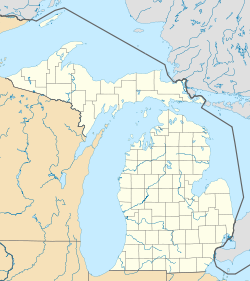Top Qs
Timeline
Chat
Perspective
MSU Museum
From Wikipedia, the free encyclopedia
Remove ads
The Michigan State University Museum, more commonly referred to as the MSU Museum is Michigan State University's oldest museum formed in 1857.[1] It is the state of Michigan's first Smithsonian Affiliate.[2][3] It was formed to support the work of the university and is also known for hosting the Great Lakes Quilt Center.
Remove ads
History
Past curators include J. Alan Holman.
This section needs expansion. You can help by adding to it. (January 2023) |
Collections
Summarize
Perspective
Cultural and historical collections
The MSU museum cultural and historical collections include anthropology, folklife, cultural heritage, and history.[4]
This section needs expansion with: Cover collection details such as number of objects, diversity and other features to describe the collection content. You can help by adding to it. (January 2023) |
Natural science collections
The MSU museum natural science collections include mammalogy, ornithology, herpetology, ichthyology, and vertebrate paleontology.[5]
This section needs expansion with: Cover collection details such as number of objects, diversity and other features to describe the collection content. You can help by adding to it. (January 2023) |
Archaeology Collections
The MSU Museum’s archaeological collection, consisting of well over a million artifacts, emphasizes Michigan archaeology, with a geographic focus on the Lower Peninsula and the pre-contact eastern Upper Peninsula. This includes a robust assemblage from the Saginaw Basin, Traverse Corridor, and eastern Upper Peninsula of Native American artifacts, as well as historical fort site collections from Michigan’s early colonial history. Noteworthy sites from the MSU campus, such as Saint’s Rest, are also included. The archaeology collections are jointly managed and cursated by the MSU Department of Anthropology and the MSU Museum.
Remove ads
Exhibitions
Summarize
Perspective
The museum hosts exhibitions to highlight the collections and complementary programs and works some rotating some permanent spread over the three floors of the museum.
Exhibition spaces
- Habitat Hall – Various dioramas of North and Central America's environments and animals as well as dinosaurs and Jurassic dinosaur skeletons.[6]
- Heritage Hall – Highlights the Great Lakes region's economic history.[7]
- Hall of Animal Diversity – Highlights different animals and their adaptions to their habitats.[8]
- Collections Connections – allows visitors to see some of the cultural artifacts and natural history specimens and show how these are stored to study and preserve for the future.[9]
- Hall of Evolution – A timeline of fossils from the Cambrian period to the Pleistocene epoch.[10]
- Second floor landing – Exploring biodiversity of things big and small. It includes a skeletons of an African bush elephant as well as an Asian elephant and a skull of a Columbian mammoth.[11]
Recent exhibitions
- 1.5 °C – Explore the impact of climate on our planet.[12]
- We All Live Downwind –[13]
- Gameplay – Experience games developed at MSU's Games for Entertainment and Learning (GEL Lab).[14]
- Science on a Sphere – A projection sphere of visualizations of Earth and other locations highlighting a variety of data visualizations an exhibit supported by the Michigan State University Federal Credit Union[15]
Past exhibitions
- Kindred – featured Odawa arts and crafts including ceramics, basketry, and beadwork from the Waganakising Odawa aka Little Traverse Bay Bands of Odawa Indians.[16]
- Michigan Barns: Timber-framed, Plank and Polebarn – featured in July 1, 2003 – July 31, 2003[17]
See also
Eli and Edythe Broad Art Museum another museum at Michigan State University.
External links
References
Wikiwand - on
Seamless Wikipedia browsing. On steroids.
Remove ads



